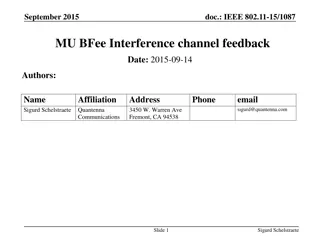Understanding Ion Channel Dysfunction in Critical Illness
An intriguing case study presents a young male with weakness and coma in the ICU following pneumonia and sepsis. Nerve conduction results indicated critical illness myopathy and polyneuropathy, along with cardiac abnormalities. Reduced muscle excitability was attributed to a sodium channelopathy. This highlights the complex interplay of ion channel dysfunction in critical illness, affecting muscle and nerve function.
Download Presentation

Please find below an Image/Link to download the presentation.
The content on the website is provided AS IS for your information and personal use only. It may not be sold, licensed, or shared on other websites without obtaining consent from the author. Download presentation by click this link. If you encounter any issues during the download, it is possible that the publisher has removed the file from their server.
E N D
Presentation Transcript
Ion Channel Dysfunction During Critical Illness Mark Rich MD/PhD Wright State University
Case History- Weakness and coma in the ICU A 22 year old male developed pneumonia, sepsis. He was intubated and treated with neuromuscular blocking agents for two weeks. He gradually improved and the blocking agents were discontinued, but he remained unresponsive with no movement of the limbs for 1 week. At this point neurology was consulted to determine why he was paralyzed and unresponsive.
Common causes of Weakness in ICU Patients 1) Critical Illness Polyneuropathy- A problem in peripheral nerves. Patients have severe weakness that persists for weeks to months after the acute illness has resolved. It is thought that axons die-the cause is unknown. 2) Critical Illness Myopathy- A muscle disease that causes severe weakness that persists for weeks to months after the acute illness has resolved.
Case study- Nerve conduction results 1) Absent sensory responses in the arms and legs. 2) Absent motor responses in the legs, small responses in the arms. 3) Direct muscle stimulation showed that muscle was inexcitable. Direct muscle stimulation Neuropathy Myopathy
Summary- Case study 1) The patient had inexcitable skeletal muscle as is found in critical illness myopathy. 2) The absent sensory responses suggest he also had critical illness polyneuropathy. 3) The patient also had low ECG amplitude and poor contractility of the heart. 4) The cause of coma remained a mystery.
In the rat model of critical illness myopathy muscle becomes less excitable.
The cause of reduced muscle excitability is a sodium channelopathy Depolarization Open Closed Continued Depolarization Repolarization Inactivated
The cause of reduced muscle excitability is a sodium channelopathy Control RP 100 Control Inactivation Excitable Inactivation Inexcitable Inactivation Normalized Current (%) 80 13.5 mV 60 Excitable RP 40 20 Inexcitable RP 0 -100 -90 -80 -70 -60 -50 Voltage (mV)
Case study re-interpreted in light of channelopathy 1) The patient likely had a sodium channelopathy making muscle inexcitable. 2) What if absent sensory responses are due to sodium channel dysfunction in nerve? 3) Could sodium channelopathy account for the abnormalities in the heart? 4) Could his coma be due to sodium channelopathy?
Reduced nerve excitability in critically ill rats is consistent with a sodium channelopathy
ECG Changes in a critically ill patient suggest reduced cardiac excitability
Changes in cardiac action potentials suggest a selective reduction in sodium current during critical illness
Reduction in motor neuron excitability during critical illness suggests that neurons in the central nervous system are also affected
Summary 1) We hypothesize that during critical illness, sodium channelopathy affects skeletal muscle, peripheral nerve, heart and the central nervous system. 2) This channelopathy could account for weakness, cardiac failure and coma. 3) It is possible that correcting the defect in sodium channels will correct much of multi-system organ failure in critically ill patients. 4) The patient woke up and recovered completely.

























